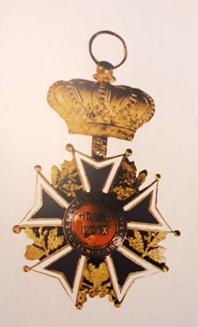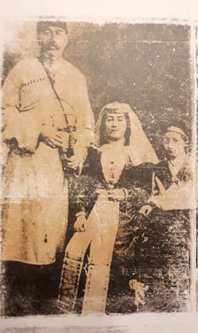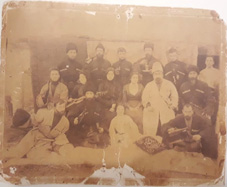
Luarsab and Dimitri Kipianis - Country of Liquid Sun
Monday, April 13
Grand Price Kipiani lived in the villages of Tola, Khvanchkara and Chorjo located at Racha-Lechkhumi border where grapes have always grown well and abundantily. The Kipianis were interested in these fertile lands and cleared them for the planting and cultivation of vineyards. Grapes of the red Aleksandrouli variety grew here in the main with the local population until present day still using them as a source for their subsistence.
This family of the well-known Racha princes originates from Svaneti with the story even told in a publication about their arrival and settlement. It was following the weakening of the power of Imereti king that the Kipianis settled in Imereti and Kartli.
At the end of the eighteenth century, the Kipianis were the landlords of the Tola and Khvanchkara villages. In Racha, their lands were located on the right side of the Rioni River, between rivers Aski and Ritsula, and included the villages of Pirveli and Meore Tola, Khvanchkara, Patara Chorjo, Bostana and Ghviara. In addition, the Kipianis owned the lands at the Buneuli Bridge where, from 1880, the famous Bugeuli "larmukoba" (fair) was held. Such public fairs used to be held in Shaori and Chrebalo as well.
Amongst the most outstanding of the Kipianis were Konstantine, Kaikhosro, Luarsab and Dimitri who were interested in wine production although they had commercial interests rather than the improvement of wine production technologies. As the local elders have told, they made no changes to the traditional wine production processes with the people of Racha still calling the wine made from Aleksandrouli grapes as "Kipiani wine." Konstantine and Kaikhosro Kipiani, however, were interested in local wine production technology and they even managed to enter the Kutaisi market with Racha wine.
At the end of the nineteenth century, the Military Road was completed which was a significant development for the region of Racha. The work had begun in 1858 and led, to a certain extent, to the revival of local life. In 1886, regular communication began between Kutaisi and Oni and five postal stations were opened. The construction of the road was followed by the opening of taverns in Ambrolauri and Oni where they served local wines although the largest market for Racha wine was in Kutaisi.
Up until the mid-nineteenth century, Chkhaveri and Ojaleshi wines were the most popular in the Guria and Samegrelo regions of West Georgia although various diseases, especially phylloxera, ruined the vineyards almost in their entirety. By 1875, Samegrelo was importing wine from Shorapani and other parts of Racha. Rachian wines were beyond the competition at all of the competition for Racha wine having disappeared at the Kutaisi market. After the construction of the Military Road, there was greater ease in the transportation of wine from Racha which led to the success of Aleksandrouli wine.
Wine traders Nestor Tsereteli and Varlam Papuashvili contributed much to the international recogniton of Aleksandrouli. They worked for Luarsab and Dimitri Kipiani and managed the commercial firm in Kutaisi established by the Kipianis in 1897. The firm was engaged in sale of wines produced by the family and those peasants from the lands of Kipianis, in possessions in Kutaisi with its cellar located in the city at 25, Tbilisi Street and where they stored and sorted wines from Racha, processing them according to the European method required, and bottling, labeling and selling them.
This firm was quite popular in Georgia at the beginning of the twentieth century and it had its own branches in the North Caucasian city of Maikop. Later, Tsereteli and Papuashvili opened a wine cellar in Batumi as well from where the Kipiani wine was exported to Russia and further abroad. Although, Kipiani wine did not gain its popularity all at once-wine initially sent to Paris received no awards-owing to the fact that the semi-sweet wine of Racha was unknown to the Europeans who were used to their dry wines. At the first agricultural exhibition in Batumi in 1900, Dimitri, Luarsab and Kaikhosro Kipiani presented their wines as well as wine those of Giorgobianis. In particular, the wine of Luarsab Kipiani was a great success and was awarded the medal with the mark of "praiseworthy. This was the first official recognition of Kipiani wine.
In 1907, Tsereteli and Papuashvili sent the wine made at the estate of Luarsab and Dimitri Kipiani to the international exhibition in the Belgian city of Oostende. Aleksandrouli wine, with the name of "Kipiani Wine," was awarded the highest prize: that is, the Grand Prize with the firm being awarded a medal with the image of Leopold II, King of Belgium. After receiving this award, the labels of Kipiani wines added four new distinctions: Grand Prize from the Oostende exhibition, the medal from the Batumi exhibition and the image of King Leopold II on both the front and back sides of the Oostende medal.
In 1904, Dimitri Kiplani established a new partnership by purchasing small parcels belonging to former landlords and expanded production in the village of Khvanchkara by enlarging the Aleksandrouli and Mujuretuli vineyards, During the Soviet period, "Kipiani Wine" was called Khvanchkara.






